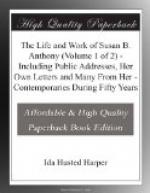The mob which had begun with the anti-slavery and gathered strength at the temperance meeting, now turned its attention to the Woman’s Rights Convention in Broadway Tabernacle. The president was that lovely Quaker, Lucretia Mott, and the speakers were among the greatest men and women in the nation: Wm. Lloyd Garrison, Wendell Phillips, Rev. Channing, Rev. John Pierpont, Mrs. Rose, Lucy Stone, Frances D. Gage, Miss Brown, Mrs. Nichols. In Miss Anthony’s address she reviewed the action of the recent teachers’ convention at Rochester and closed by saying: “A woman principal in that city receives $250, while a man principal, doing exactly the same work, receives $650. In this State there are 11,000 teachers and of these four-fifths are women. By the reports it will be seen that of the annual State fund of $800,000, two-thirds are paid to men and one-third to women; that is to say, two-thirds are paid to one-fifth of the laborers, and the other four-fifths are paid with the remaining one-third of the fund!” This was the first appearance of Madame Mathilde Anneke, a highly-educated German of noble family, a political exile from Hungary, and a friend of Kossuth. That wonderful colored woman, Sojourner Truth, also was present.
The resolutions were, in effect, that “each human being should be the judge of his or her sphere and that human rights should be recognized.” There never were, there never will be, grander speeches than those which were made on this occasion, and yet the entire convention was in the hands of a mob. The women, as well as the men, were greeted with cries of “shut up,” “sit down,” “get out,” “bow-wow,” “go it, Susan,” and their voices drowned with hisses and cat-calls. The uproar was indescribable, with shouting, yelling, screaming, bellowing, stamping and every species of noise that could be made. Horace Greeley went down among the crowd and tried to quiet them. The police were appealed to in vain, and the meeting finally closed in the midst of tumult and confusion. The Tribune under the management of Greeley, and the Evening Post under that of William Cullen Bryant, condemned the rioters with the greatest severity, but the other leading dailies of New York sustained the mob spirit and made the ladies a target for ridicule and condemnation.
After leaving New York, Miss Anthony went to the Fourth National Woman’s Rights Convention at Cleveland, O., which was one of the largest and most enthusiastic that had been held. It was attended by many noted people, among them Hon. Joshua R. Giddings, always a consistent advocate of woman’s rights, and the proceedings were marked with perfect order and propriety. Miss Anthony was continued at the head of the finance committee, as it was found that no one could raise so much money. The three weeks following she traveled through the southern counties in New York and spoke in a number of villages. A year before she had gone over the same ground and organized woman’s temperance societies. She found that, with the exception of one at Elmira, none of these was in existence. The explanation in every instance was that they had no money to secure lecturers, or to do any practical work and, as all the members were wives and housekeepers, they were not in a position to earn any. Miss Anthony makes this entry in her journal:




